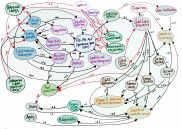
Lecture at the 4th National Conference of STS Italia – Italian Society of Science and Technology Studies, Rovigo, 21 to 23 June 2012 organised in partnership with CIGA of the University of Padua (Centre for Environmental Law Decisions and Corporate Ethical Certification)
Debt as a regulatory principle of informational disequilibria.
Abstract
“My analysis starts from the concept of debt which Maurizio Lazzarato understands in terms of an operational element driving both society as a whole, as well as subjectivity in its molecular production : by following Deleuze’s analysis of economic flux, the Italian philosopher describes debt in terms of generation of asymmetry and differential relations of power.”
“My inquiry addresses the question of how to shift Lazzarato’s economic and existential description towards the realm of bioinformational production. This means to think debt in terms of its abstract function of a dispositive penetrating into the dividual interstices between digital circulation and affective dynamics, between the production of physical and biological matter. It means to grasp, through the perspective of debt, the asymmetric aspect of information circulation, the moment in which information is understood in its pure differentiality, in its tension between not yet related fragments.”
“Energetical considerations are the starting point for this question. By departing from a brief revision of the concept of individuation ideated by Gilbert Simondon – concept which describes a processual genesis from an initial disparity of potential energy – I come to delineate the core ideas of recent quantum mechanical research, which aims to redesign the web from the point of view of new transmission rules.”
“From the perspective that these futuristic research opens up, I come back to the concept of debt, which on the contrary, does not imply an enhancement but a closure of possibilities and coming connections. Starting from the paradox of a society which is ruled by (at least) two velocities, – the digital one reaching dimensions which are proximal to light, and the socio-economic one acting towards a decrease of velocity and an obstruction of the general intellect – I ask the question of what mechanisms of future fluxus will be able to cross the interstice between the existential and the technological, between the mechanisms of digital and of affective production.”































